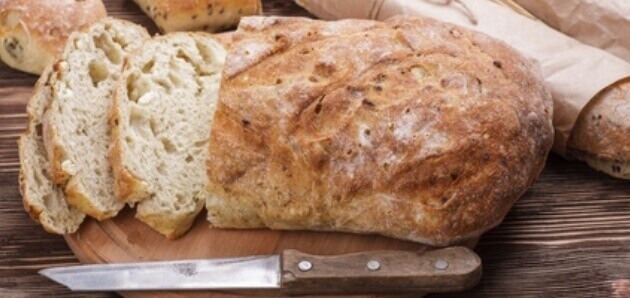
Can you bring bread on an airplane? Are the rules different for domestic and international flights? And just how long will bread remain safe to eat when packed in your luggage? Read on for the answers.
|
Bringing Bread On A Plane |
|
|
Can You Bring Bread on Domestic Flights Within the U.S.A.? |
|
|
Carry-On Baggage: |
Yes |
|
Checked Luggage: |
Yes |
|
|
|
|
Can You Bring Bread on International Flights Originating in the U.S.A? |
|
|
Carry-On Baggage: |
Yes* |
|
Checked Luggage: |
Yes* |
|
|
|
|
* You can bring bread on board and consume it during the flight. But you might not be able to bring bread into your foreign destination (see details below). |
|
|
|
|
|
Can You Bring Bread Into The U.S.A. on an International Flight? |
|
|
Carry-On or Checked Luggage: |
Yes in most cases |
|
|
|
|
How Long Will Bread Last In Your Luggage? |
|
|
Bread, hard-crusted: |
1 to 2 days at room temperature
|
|
Bread, soft-crusted: |
4 to 7 days at room temperature |
Sources: Transportation Security Administration, U.S. Customs and Border Protection, StillTasty.com
BRINGING BREAD ON A PLANE: FLIGHTS ORIGINATING IN THE U.S.A.
Can you bring bread through airport security in your carry-on baggage?
Yes, the Transportation Security Administration (TSA) will allow you to bring bread through airport security in your carry-on baggage. You can bring a whole loaf of bread or individual slices through the TSA checkpoint, and both store-bought and homemade bread are allowed. Any type of bread is typically fine, including hard or soft-crusted breads, rolls, biscuits, buns, baguettes, pita bread, quick breads like banana bread and cornbread, and tortillas.
If the bread isn’t already pre-packaged, it should be wrapped or placed in a resealable bag or container with a secure lid. There is no limit to the quantity of bread you can bring in your carry-on: You can pack as much bread as you’d like and will fit into your allowable hand luggage.
Read more: Here are the foods you can bring through airport security
Can you bring bread that has been spread with butter through airport security?
Yes, The TSA will allow buttered bread, rolls, biscuits, and other types of breads to pass through airport security, as long as they are wrapped or in a container.
Can you bring bread on an airplane in your checked baggage?
Yes, you can bring bread in your checked baggage when boarding a flight within the United States. You can bring as much bread as you’d like in your allowable checked luggage. To prevent bread from getting crushed, pack it in sturdy containers with tight-fitting lids.
Can you bring bread on an international flight leaving the U.S.A.?
Yes, you can bring bread on an international flight departing from the U.S., either in your carry-on baggage or your checked luggage. If your intention is to bring the bread onto the plane in your carry-on baggage and consume it during the flight, you’ll have no issues. The TSA applies the same rules for allowing bread through security at U.S. airports, whether you are flying domestically or internationally.
You can also bring bread into many foreign countries. But some countries may restrict or prohibit homemade bread — Mexico, for instance, does not allow most homemade food into the country. Be sure to check your foreign destination’s rules before leaving.
BRINGING BREAD INTO THE UNITED STATES
Can you bring bread on an international flight back into the U.S.A.?
Yes, the United States generally allows travelers to bring bread into the U.S. when arriving on a flight from a foreign country.
Note that even though bread is typically allowed, you must declare all foods that you bring into the United States — whether they are allowable or not — to U.S. Customs and Border Protection (CBP). The penalties for failing to declare your food items can be steep; bear in mind also that the CBP routinely conducts random screenings for arriving passengers.
FOOD SAFETY: HOW LONG WILL BREAD LAST IN YOUR LUGGAGE?
Soft-crusted bread will usually remain safe to eat for about 4 to 7 days when stored at room temperature. Hard-crusted breads will keep fresh for a day or two at room temperature.
Note: While the above information is based on applicable Transportation Security Administration (TSA) and U.S. Customs and Border Protection (CBP) guidelines at the time of publication, the final decision for whether to allow a food item through airport security or into the United States rests with the TSA and CBP officers on duty at the airport. Regulations also change frequently: For the latest information, check the US Customs and Border Protection and Transportation Security Administration websites.